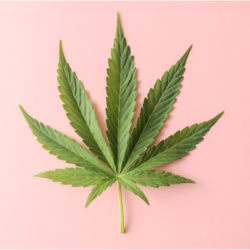In recent months, many products containing cannabidiol (CBD) have appeared on the French market . Unlike THC, CBD is a non-competitive antagonist of CB1 receptors and therefore does not exhibit the psychotropic effects of THC. However, it has multiple actions on numerous receptors or molecules of the central nervous system inducing anti-inflammatory, antispasmodic, analgesic or even anticonvulsant effects, but it is also a powerful inhibitor of cytochromes P450 which can lead to numerous drug interactions .
The role of CBD in the reduction of certain symptoms in the somatic domain
CBD is an effective pain reliever and anti-inflammatory . It effectively reduces the symptoms of acute and chronic pain , or even those induced by heavy treatment, without the addictive effect of certain existing drugs.
In addition, it is useful for the treatment of chronic inflammatory bowel diseases such as Crohn’s disease . CBD also has antioxidant properties believed to be effective against inflammation of the skin such as psoriasis.
In the various studies carried out, a reduction in pain can be observed , in particular in people suffering from cancer or arthritis.
The role of CBD in the reduction of certain symptoms in the psychic domain
CBD indeed has relaxing and soothing virtues , and reduces stress . In particular, it is given anxiolytic effects because it provides many benefits to people suffering from post-traumatic stress .
CBD also causes positive effects on mood as well as sedative properties for improved sleep . In addition, it is endowed with an antipsychotic action potential which helps patients suffering from schizophrenia, bipolar disorder , depression or other mental disorders . Plus, unlike other antipsychotic drugs, CBD is devoid of side effects.
Regarding the anxiolytic effects, several studies, mainly carried out on animals, suggest that CBD reduces stress and anxiety in both behavioral and physiological aspects. It would even seem that anxiolytic effects are observable from taking small doses of CBD, namely less than 5 mg per kilo. Clinical studies with human subjects support this and suggest that CBD is, in fact, effective in reducing anxiety.
CBD in the prevention of chronic and neurodegenerative diseases, and in strengthening the immune system
More specifically, CBD prevents the growth of tumors by limiting the migration of cancer cells which can thus prevent the appearance of metastases . It also activates apoptosis, (ie a process by which cells trigger their self-destruction). It would thus be effective against various tumor diseases and cancers . In addition, through neuroprotective effects , CBD can reduce the severity of symptoms in certain neurodegenerative diseases . It makes it possible, for example, to prevent certain cognitive disorders in patients suffering from Alzheimer’s , or in persons suffering from.diabetes , it reduces high blood pressure , which can lead to long-term complications such as cardiovascular disease , and may even stabilize blood sugar levels .
The effectiveness of CBD in preventing or treating serious and / or chronic illnesses has so far been widely studied and documented. CBD provides beneficial effects in the treatment of several diseases in which activation of the immune system is involved, such as cancer, Alzheimer’s disease, multiple sclerosis , type I and type II diabetes, the disease Parkinson’s , Huntington’s chorea, arthritis, and other brain disorders or inflammation. It benefits in particular from anti-inflammatory and immunomodulatory effects, namely that it stimulates or slows down reactions of the immune system, as well as neuroprotective effects by protecting brain cells. As an example, several animal studies have shown a decrease in the growth of cancerous tumors and an inhibition of metastases with the administration of CBD.
Other clinical trials have found improved quality of life in Parkinson’s disease, as well as beneficial effects on spasticity in multiple sclerosis. An improvement in cognitive and locomotor activity has also been observed in Alzheimer’s disease and other neurological disorders.
The interest of CBD in the treatment of diagnosed neurological disorders
In a lot of research, it turned out that CBD can also treat or reduce symptoms related to different forms of epilepsy or other neurological disorders (eg multiple sclerosis). It is particularly promoted as an effective treatment to prevent or reduce epileptic seizures . The anticonvulsant effects of CBD also apply to seizures induced by other neurological disorders.
Indeed, several studies and reports have shown the anticonvulsant effects of CBD . This research suggests in particular that CBD – between 25 and 50 mg per kilo administered over a period of three months to a year – could decrease the frequency of seizures. A number of studies have tested the effects of CBD in children with a severe and rare form of treatment-resistant epilepsy – Dravet syndrome – and have found relatively positive results with the administration of CBD, at at 25 mg per kilo for three months, compared to the administration of a placebo.
CBD and drug interactions
Like all substances containing active ingredients, the risk of drug interactions must therefore be taken into account.
A potent inhibitor of cytochromes P450, CBD is metabolized by CYP3A4 and 2C9, which results in numerous pharmacokinetic interactions.
Drugs with a narrow therapeutic window:
A number of drugs are known to have a narrow therapeutic margin (TEA), ie the difference between the concentration required to have a beneficial effect and that which is toxic is small. The risk of toxic overdose (as in the case of CBD being an enzyme inhibitor) or of underdosing (in the case of enzyme inducers – lack of therapeutic effect) is very high with these products. Various factors can modify the kinetics of these products, in particular, to quote only the one which interests us: co-administration with a substance inducing or inhibiting hepatic metabolism.
Pharmacokinetic interactions:
Pharmacokinetic interactions are linked to a change in the fate of the drug in the body. In the case that interests us, interactions appear between drugs metabolized by the same enzymatic systems:
- The enzyme inducers accelerate the metabolism of other molecules and reduces their therapeutic activity; it is the escape of treatment.
- The enzyme inhibitors (as is the case of CBD) slow metabolism and increase the amount of drugs in the body; there is therefore a risk of the appearance of undesirable effects linked to an overdose.
Drugs metabolized by the cytochrome P450 isoenzyme CYP 3A4 and CYP 2C9 (non-exhaustive list):
- Anticancer
- Antiarrhythmics
- Calcium channel blockers
- Antihypertensives
- Statins
- Synthetic diuretics
- Vasodilators
- Anti coagulants
- Antiplatelet agents
- Hypoglycemic
- Nonsteroidal anti-inflammatory drugs (NSAIDs)
- Opioids
- Progestins
- Immunosuppressants
- Migraine medications (including triptans)
- Neuroleptics
- Benzodiazepines and related drugs
- Antidepressants
- Corticosteroids
- H1 antihistamines
- Atropine
- Antiretrovirals
- Antibiotics
- Azole antifungals
- Oral antidiabetics
In summary, any inhibitor of CYP2C9 and / or 3A4 is likely to increase plasma concentrations of CBD and therefore adverse effects. Co-prescribing such substances therefore requires monitoring the occurrence of cannabinoid-type unwanted effects and reducing the dosage if necessary. Conversely, enzyme inducers such as anticonvulsants could in theory reduce CBD concentrations, and therefore their effectiveness.
For these reasons, CBD treatment should not be used for self-medication. CBD should require the advice of your doctor beforehand and consumed as part of medical supervision.
Medical bibliographic sources and clinical trials :
-
Stout SM, Cimino NM. Exogenous cannabinoids as substrates, inhibitors, and inducers of human drug metabolizing enzymes: A systematic review. Drug Metab Rev 2014
-
Borgelt LM, Franson KL, Nussbaum AM, et al. The pharmacologic and clinical effects of medical cannabis. Pharmacotherapy 2013
-
Yamaori S, Okamoto Y, Yamamoto I, et al. Cannabidiol, a major phytocannabinoid, as a potent atypical inhibitor for CYP2D6. Drug Metab Dispos 2011
-
Yamaori S, Maeda C, Yamamoto I, et al. Differential inhibition of human cytochrome P450 2A6 and 2B6 by major phytocannabinoids. Forensic Toxicol 2011
-
Stott CG, White L, Wright S, et al. A phase I study to assess the single and multiple dose pharmacokinetics of THC / CBD oromucosal spray. Eur J Clin Pharmacol 2013
-
Abrams DI, Couey P, Shade SB, et al. Cannabinoidopioid interaction in chronic pain. Clin Pharmacol Ther 2011
-
Drug interactions and cytochromes P450. Geneva 2014
-
Whiting, PF, Wolff, RF, Deshpande, S., Di Nisio, M., Duffy, S., Hernandez, AV, Keurentjes, C., Lang, S., Misso, K., Ryder, S., Schmidlkofer, S., Westwood, M. & Kleijnen, J. 2015
-
Volkow, ND (2015, June). The biology and potential therapeutic effect of cannabidiol. Senate Caucus on International Narcotics Control.
-
Russo, EB (2017). Cannabidiol Claims and Misconceptions. Trends in Pharmacological Sciences
-
Russo, EB (2011). Taming THC: potential cannabis synergy and phytocannabinoid-terpenoid entourage effects
-
National Academies of Sciences, Engineering, and Medicine (2017). The health effects of cannabis and cannabinoids: The current state of evidence and recommendations for research
-
Morabito, D., Soyster, P., Ramey-Wright, S., Belendiuk, KA & Bonn-Miller, MO (2016). A Review of Recent Advances in the Therapeutic Uses of Secondary Cannabinoids. Current Addiction Reports
-
Marthaler, M. Udrisard, R. und Zobel, F. (2016). Rekrutierung von Teilnehmenden für die europäische online Drogenbefragung
-
Iffland, K. & grotenhermen, F. (20179. An update on safety and side effects of cannabidiol: a review of clinical data and relevant animal studies
-
Hahn, B. (2017). The Potential of Cannabidiol Treatment for Cannabis Users With Recent-onset Psychosis
-
Grotenhermen, F. & Müller-Vahl, K. (2017). Medicinal Uses of marijuana and Cannabinoids
-
Campos, AC, Fogaça, MV, Sonego, AB & Guimarães, FS (2016). Cannabidiol, neuroprotection and neuropsychiatric disorders
-
Burstein, S. (2015), Cannabidiol (CBD) and its analogs: a review of their effects on inflammation
-
Aran, A., Cassuto, H., Lubotzky, A., Wattad, N. & Hazan, E. (2018). Brief Report: Cannabidiol-Rich Cannabis in Children with Autism Spectrum Disorder and Severe Behavioral Problems-A Retrospective Feasibility Study
-
Rev Prescribe 2011; 31 (338 suppl. Drug interactions)





